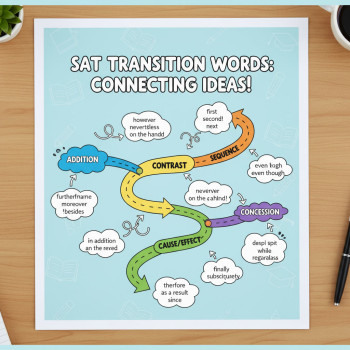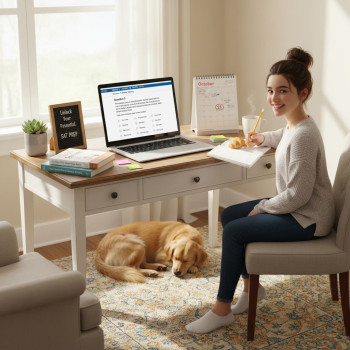Why the Place You Study Matters (More Than You Think)
Ask any student what their ideal study setup looks like and you’ll get wildly different answers: a quiet bedroom, a bustling coffee shop, a library nook, or even the passenger seat of a car. The truth is, environment shapes focus. For students preparing for the Digital SAT, rotating study environments intentionally—rather than relying on a single go-to spot—can sharpen attention, reduce burnout, and help you perform better on test day.
The science in plain language
Our brains build context around habits. When you always solve practice math problems at your desk, that desk becomes a cue: your brain starts preparing for math. That’s useful—until it isn’t. If every practice session happens in one place, your brain learns the context more than the skill. Rotating environments helps the brain encode learning more flexibly, making recall stronger in varied situations—like the actual test center or a strange testing device. For the Digital SAT, where you’ll be using a device in a test center and managing tools like the built-in calculator and digital highlighting, adaptability is an advantage.
The goals of rotating study environments
Rotating isn’t random hopping from place to place. It’s strategic variation with clear goals:
- Prevent mental fatigue and boredom by changing sensory input.
- Train focus in both high- and low-distraction settings.
- Build transferability so skills apply anywhere—especially on test day.
- Match topics or tasks to environments that naturally support them (e.g., reading in quiet spaces; timed sections in slightly busier spots to simulate pressure).
How this ties to the Digital SAT specifically
The Digital SAT has subtleties: adaptive sections, screen navigation, time pacing, and digital tools. Practicing only in a quiet bedroom on a personal laptop won’t prepare you for the test-day routine if your testing environment differs. A rotation plan that includes at least one session on the Bluebook app (or a device similar to your testing device), a session in a busier place, and a calm review session can reduce surprises and improve confidence.
Designing your study-environment rotation: a step-by-step plan
Below is a practical plan you can customize. Think of it as a weekly template you tweak based on personality, schedule, and how close you are to the test.
Step 1 — Identify four core environment types
Choose four distinct places you can reasonably access. Keep them consistent so your brain learns their cues.
- Quiet Focus Zone — your bedroom desk, a private study room, or a quiet library corner for deep work.
- Simulated Test Zone — school computer lab or the exact device and Bluebook setup you’ll use on test day.
- Moderate-Distraction Zone — a campus coffee shop, a family living room, or a public library lounge to build concentration with mild background noise.
- Active Review Zone — a walking route, a park bench, or a car ride for passive review like flashcards, vocabulary, or listening to recorded explanations.
Step 2 — Map study tasks to zones
Not every task fits every zone. Match depth of cognition to the environment:
- Quiet Focus Zone: hard problem sets, intense reading passages, and full-length practice sections that require deep reasoning.
- Simulated Test Zone: full-length Bluebook practice tests, timed sections, and navigation rehearsals.
- Moderate-Distraction Zone: mixed practice, timed drills, endurance building, and practicing focus while mildly distracted.
- Active Review Zone: vocabulary, formula review, listening to strategy talks, and light recall exercises.
Step 3 — Build a weekly rotation schedule
Here’s a sample schedule you can adapt. It prioritizes variety without being chaotic.
| Day | Zone | Session Type | Duration |
|---|---|---|---|
| Monday | Quiet Focus Zone | Reading & Writing deep work (timed passages) | 90 minutes |
| Tuesday | Moderate-Distraction Zone | Mixed practice & pacing drills | 60 minutes |
| Wednesday | Active Review Zone | Flashcards & audio lessons (walk or commute) | 30–45 minutes |
| Thursday | Simulated Test Zone | Bluebook timed section or half test | 60–90 minutes |
| Friday | Quiet Focus Zone | Targeted math practice (problem sets) | 75 minutes |
| Saturday | Simulated Test Zone | Full-length practice test (Bluebook) | 3–4 hours |
| Sunday | Active Review Zone | Light review, reflection, and plan next week | 30–60 minutes |
This template balances focused skill-building with realistic simulation and low-effort review. If you’re two weeks out from test day, increase Simulated Test Zone sessions. If you’re months away, prioritize skill development and spacing practice across zones.
Practical tips to make each zone effective
Quiet Focus Zone — set up for deep work
- Clear surface, comfortable chair, good lighting.
- Have a paper backup of strategy notes; sometimes writing helps lock in ideas.
- Turn off notifications; use a simple ambient timer (Pomodoro) to protect attention.
Simulated Test Zone — rehearse the whole experience
- Use Bluebook or an identical device setup; complete exam setup exactly like test day including login steps.
- Wear the clothes and use the headphones (if applicable) you plan to bring on test day to reduce surprises.
- Time your breaks as the real test does and practice pacing with the on-screen tools.
Moderate-Distraction Zone — build resilience
- Choose a consistent, mildly noisy place. The point is simulated pressure—not chaos.
- Practice short, timed drills to strengthen focus amid background sound.
- Work on questions that require quick thinking and avoid tasks needing long, uninterrupted reasoning that could be unfairly disrupted.
Active Review Zone — maximize low-effort learning
- Use voice notes for tricky grammar rules or mnemonic devices and listen while walking.
- Review formula sheets or flashcards while commuting or waiting between classes.
- Keep a lightweight notebook for insights and small wins—these are great confidence boosters.
How to measure whether rotation is working
Track two kinds of signals: objective and subjective.
- Objective: practice test scores, time-on-question analytics (from Bluebook or practice reports), and error patterns per section.
- Subjective: perceived focus, energy after sessions, and how often you felt distracted or refreshed.
Keep a weekly log: note where you studied, what you did, how focused you felt (scale 1–5), and any performance metrics. After 3–4 weeks you’ll see patterns: maybe your math accuracy rises in the Quiet Focus Zone while timing improves in the Moderate-Distraction Zone. Use those insights to rebalance your rotation.
Simple tracking table
| Week | Primary Zone | Avg Focus (1–5) | Practice Score Change | Note |
|---|---|---|---|---|
| 1 | Quiet Focus | 4 | +10 (Reading) | Strong deep work, reduce session length to avoid fatigue |
| 2 | Simulated Test | 3 | +4 (Math timing) | Need more Bluebook navigation practice |
Common pitfalls and how to avoid them
Pitfall: rotating too often or too chaotically
If you change environments every hour you’ll never settle into productive flow. Keep each session purposeful: rotate zones across days rather than minutes.
Pitfall: mismatching tasks to environment
Don’t try to do deep-reading passages in a noisy food court. Use matching—deep work in quiet, stamina and timing drills in moderate noise, and passive review during active movement.
Pitfall: ignoring the simulated test
Some students never practice on the exact digital platform they’ll use. That creates friction on test day. Make the Simulated Test Zone non-negotiable—at least once a week increase this as the test approaches.
Study-rotation examples for different students
One plan doesn’t fit all. Here are three tailored rotations based on how much time you have and your personality.
The Busy Student (6–8 hours/week)
- 2 × Quiet Focus (90 min each) — deep practice for toughest topics.
- 1 × Simulated Test (Bluebook half test, 90 min).
- 2 × Active Review (30 min walk/listen sessions).
- 1 × Moderate-Distraction (60 min timed drill).
The Committed Student (12–15 hours/week)
- 2 × Full-length Simulated Test (one weekend, one midweek half-test).
- 3 × Quiet Focus (math/problem sets and reading deep work).
- 2 × Moderate-Distraction (timed pacing and endurance).
- 3 × Active Review (vocab and formula recap).
The Anxiety-Prone Student (8–10 hours/week, prefers gentle exposure)
- Start with more Active Review sessions to build confidence.
- Introduce short Simulated Test Zone sessions (30–45 min) once a week.
- Use Quiet Focus for targeted problem-solving, but keep sessions shorter and frequent.
- Gradually increase Moderate-Distraction exposure to build tolerance.
How Sparkl’s personalized tutoring can fit into your rotation
Personalized tutoring is most effective when it complements and strengthens this rotation strategy. For example, you can:
- Schedule a Sparkl 1-on-1 tutoring session after a Simulated Test to review mistakes with an expert tutor the next day, when memory is fresh.
- Ask a Sparkl tutor to help design targeted practice for your Quiet Focus sessions—tutors can create tailored study plans that plug into each zone.
- Use Sparkl’s AI-driven insights (if available through their platform) to analyze practice test patterns and recommend which zone to prioritize next week.
When used naturally—rather than shoehorned in—personalized tutoring acts like a force multiplier for a rotation strategy. It accelerates feedback loops, helps you stay accountable, and translates practice into measurable score gains.
Test-day rehearsal: make one zone mimic the actual day
A week or two before the test, convert one or two Simulated Test Zone sessions into full rehearsals:
- Arrive at your simulated test location at the same time you’ll arrive on test day.
- Set up device exactly the way you’ll on test day and go through the Bluebook check-in process.
- Wear the outfit you plan to wear. Bring the same snacks and water to replicate breaks.
- Do a full test or at least full sections back-to-back to recreate endurance demands.
These rehearsals reduce unknowns and help your nervous system stay calm during the real event.
Final checklist: before you rotate
- Reserve your Simulated Test Zone time on the calendar; treat it like a real appointment.
- Prepare quick kits for each zone: headphones, chargers, printed formula sheet, flashcards.
- Keep a simple log and review weekly to see what’s working.
- Adjust based on results—if a zone isn’t helping, swap it out for another trial environment.
Parting thought: rotate with purpose, not chaos
Rotating study environments is about strategic variation. It’s not a productivity trend; it’s a practical approach to make your SAT practice more robust, flexible, and realistic. By pairing deep work with realistic simulations, you’ll reduce surprises on test day and build the kind of focus that sticks in new settings.
Finally, remember that help makes a difference. Whether you plug in occasional 1-on-1 guidance from Sparkl to refine technique, use tailored study plans to focus your Quiet Focus sessions, or lean on expert tutors to interpret practice analytics, thoughtful support fits naturally into a rotation and speeds progress without masking where the real work happens: your daily, intentional practice.
Ready to try it?
Pick your four zones, map your week, and commit to one full Simulated Test each weekend for the next month. Track your focus and scores, make small adjustments, and celebrate the incremental wins. That steady, varied practice is the clearest path from prepping to performing.
Good luck, and study smart—your best test day is built one intentional session at a time.
















No Comments
Leave a comment Cancel